Community Planning: Methods
Ketso kit
- description
- more detail
- more pictures
Ketso is a colourful, hands-on and re-usable toolkit for creative engagement. It enables people with differing levels of confidence and ability to engage and share ideas. Ketso can be used at many stages in a project: from developing a brief, to design and planning, to developing and implementing an action plan. The word 'Ketso' means 'Action' in Lesotho, Southern Africa, where the kit was pioneered.
A Ketso kit provides a set of tabletop materials that can be used to capture and display people's ideas. Participants, in a workshop setting, write their ideas and comments on coloured shapes, and place them on a central, felt workspace. The ‘branches’ on the kit can be used to give themes for participants to think about.
A carefully designed facilitation process enables all participants' views to be expressed and stimulates both individual and group thinking, which is needed for any successful project.
The kit is highly portable - at the end of a workshop, it folds quickly and easily into a carrying bag. The results can be written up or photographed, fed back to participants and used as the basis of a report. The kit pieces rinse clean in water, ready for reuse.
A Ketso kit provides a set of tabletop materials that can be used to capture and display people's ideas. Participants, in a workshop setting, write their ideas and comments on coloured shapes, and place them on a central, felt workspace. The ‘branches’ on the kit can be used to give themes for participants to think about.
A carefully designed facilitation process enables all participants' views to be expressed and stimulates both individual and group thinking, which is needed for any successful project.
The kit is highly portable - at the end of a workshop, it folds quickly and easily into a carrying bag. The results can be written up or photographed, fed back to participants and used as the basis of a report. The kit pieces rinse clean in water, ready for reuse.
Extensive backup is provided on a website: workshop plans; examples; case studies; analysis templates; training videos – www.ketso.com
Photocredits
top: Gavin Duthie, courtesy of Beacon North East.
middle: Nick Wates.
bottom: Ketso Ltd (Enterprise skills training, University of Durham)
top: Gavin Duthie, courtesy of Beacon North East.
middle: Nick Wates.
bottom: Ketso Ltd (Enterprise skills training, University of Durham)


Using the kit
Participants write their ideas and comments on colour-coded shapes, and place them on a central, felt workspace. Everyone can see the group’s thoughts taking shape, encouraging cooperation and dialogue.
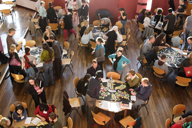
Numbers
Ketso extends your capacity. If you are new to running a workshop, it gives you simple stages and something to do with participants. If you are more experienced, it means you can run creative workshops with many people at once.
Sample Ketso workshop process
-
1. Arrivals and warm-up
- Existing Assets – what is good about the area? What is working well that we should make the most of? (on brown leaves)
- Future Possibilities – what could be done differently? Creative thinking, not worrying about practicalities at this point. (green leaves)
People sit at tables of 6-8. Facilitator introduces the kit by asking participants a warm-up question and inviting them to write their answers on ‘leaves’ (already on the tables). Typical question: ‘In an ideal world, what would you like to see in this area?’
2. Introductions
Facilitator explains aims, the Ketso approach, people invited. Participants introduce themselves at their tables.
3. Assets and possibilities
Facilitator asks a question and participants write or draw ideas on leaves, then take it in turns to share their ideas as they place them on the felt workspace. Questions might be:
4. Table Swap
Participants change tables and see another group’s ideas. These can be highlighted or commented on (using special icons). Participants return to original tables.
5. Break
6. Generating actions
Key challenges – what are the barriers to the desired future possibilities (grey leaves)?
Solutions to challenges – more creative thinking, specifically about how to overcome the challenges identified (green leaves).
Identify priorities – decide as a group which of the ideas on the workspace are most important (icons).
Develop goals – what goals are suggested by the priorities identified? (yellow leaves)
Next steps & actions – towards achieving the goals (using the Ketso Planner)
7. Final plenary
8. Feedback
The kit is packed up. Later it can be photographed to make a record of the ideas generated, or written up for a report to feed into future events or planning. The Ketsos or Actions from the workshop may also be taken forward into a future workshop, starting from where the first workshop left off.
Running time: 2 - 4 hours. Ideal numbers: 15 - 25. With larger numbers, additional facilitation assistance is required.
Tips
- See www.ketso.com for free training videos and a growing library of workshop plans that you can adapt to suit your needs.
- Ideas and action plans generated from a session can be captured in downloadable excel worksheets and then translated into concise reports.
- Ketso is designed to support people in running their own workshops, but the Ketso team can recommend experienced facilitators if required.
Costs
-
A Ketso kit can be rented or bought. A Ketso 8 (enough for a workshop of 8) costs £50 per month to rent and £249 to buy. A Ketso 24 (enough for a workshop of 24) costs £70 per month to rent and £499 to buy (2011 prices). (If a kit is bought following a rental, then the rental price is deducted from the purchase cost.) Please enquire for prices in other currencies.
Other costs may include: venue hire; refreshments; fees for an external facilitator (if used).
Development and sponsorship
-
The Ketso kit was pioneered in Southern Africa by Joanne Tippett before being developed in her research at The University of Manchester, UK.
Kit development supported by University of Manchester Intellectual Property (UMIP) and the University of Manchester and developed in research sponsored by: the Economic and Social Research Council, Mersey Basin Campaign, Irk Valley Project, Newlands Project, Sustainable Consumption Institute, Manchester City Council and the Environment Agencyy.
Inspiration and insight
- "The most significant aspect of pioneering Ketso in Southern Africa was the evident benefit to people’s sense of hope and self-confidence, helping them to become aware of the possibilities for improving the quality of their lives, through using their own creativity and the resources available to them."
-
"A lot of people are like me, and they are not good at speaking if there are more than 2 or 3 people around. They have things to say, but they don't really participate. This [Ketso] is magnificent at getting people to participate, and very important."
-
"I like the idea of ‘putting the pens in the hands of the residents,’ because normally the landscape architects make the plan, and we take it back to the residents. With this, the residents sat around the table discussing amongst themselves where they think things should be placed on the map. I think it made a big difference in the final plan. I thought that was really, really exciting."
-
"It’s very hard to fall out with the CEO of an organisation when he has exactly the same size leaf to write on as you do. Ketso is a great leveller."
- "I'm amazed at how much we got through in two hours, and by the quality and quantity of the ideas people came up with. Ketso prevents you getting bogged down."
- "There was none of that big felt tip and a flip chart piece of paper stuff that drives you demented and drives everybody else demented as well, writing big lists of things that you then talk about one by one and people fall asleep and then you throw the piece of paper away. There was none of that. It was much better."
Reviews and Comments
-
"Several participants saying they were amazed at how much they had accomplished in the short period of time. Participants felt that the interactive toolkit helped them to ‘see a bigger picture’, and enabled them to ‘hear other people's views and ideas"
Fellside Forum, Kendal, UK, report on workshops held in 2010
-
"It helped work though a complicated project in an organised way and pick out key objectives."
Leeds City Council, Energy Guardians Project, 2010
-
"The outline of a plan and a series of priorities were possible within a very short time and without the formalities of PowerPoint and other corporate presentation methods."
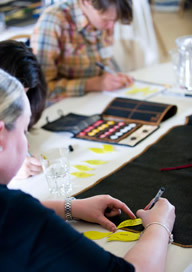
Ketso workshop
Time for participants to develop ideas before sharing them
Photocredit: Gavin Duthie, courtesy of Beacon North East, 2011.
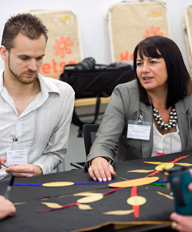
Workshop
Group discussion with Ketso, 2012
Photocredit: Gavin Duthie, courtesy of Beacon North East, 2011.
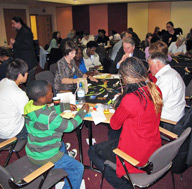
Ketso engages all ages
Community engagement in health, 2009
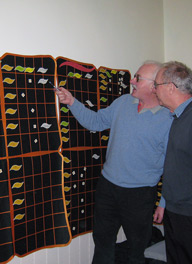
Ketso grid
Using a wall mounted matrix for action planning and consulting on options, 2009.

Ketso in South Africa
Back where it all started, 2010
Thanks: Elaine Speakman and Dr Joanne Tippett, Ketso Ltd., School of Environment and Development, University of Manchester, UK
Funded by the Building Community Consortium.
Funded by the Building Community Consortium.